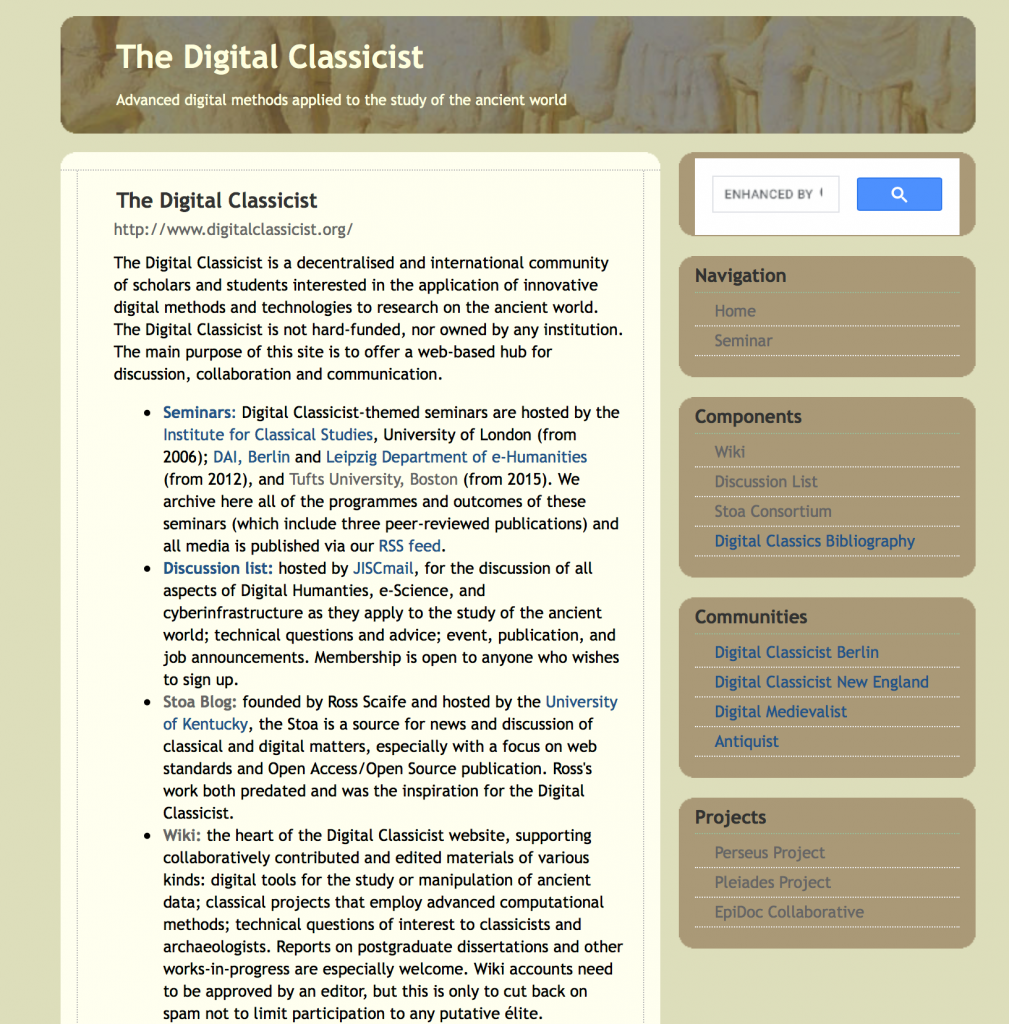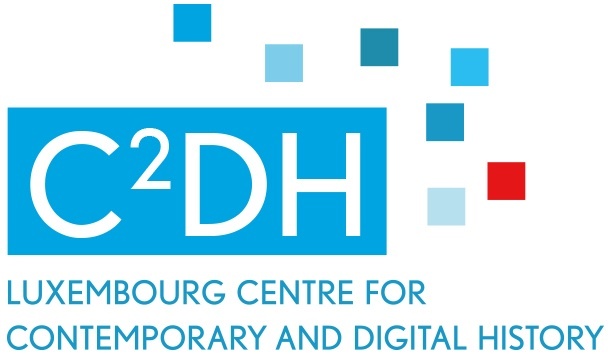Given the nature of current discussions on the impact of digital technologies and methods on classical studies, you could be forgiven for feeling like Theseus looking for a way of escaping from the maze. At one end stand concerns about a possible “sacrifice” of the traditional methods and epistemic culture of your discipline, while at the other end there are new possibilities for analysis, interpretation and dissemination of results. 1 Between the two much discussion is going on, so you might feel the need for a guide – or rather a translator – who can help you find your way. In short: you need Ariadne’s help.
Let me give a brief recap of the Greek myth I am referring to: Ariadne was the daughter of Minos, the king of Crete. She was in charge of the labyrinth where seven Athenian boys and girls had to be sacrificed every seven or nine years to the Minotaur, a creature that was half man, half bull. One year, Theseus, the son of the Athenian king Aigeus, was part of the group. Ariadne fell in love with him and helped him to escape from the labyrinth by providing him with a ball of thread.

The state of the “Arts”
This brief excursion into ancient mythology provides a rather apt illustration of the state of discussion not only in classics but in the humanities in general. In this blog post, I will concentrate on contributions arising from the field of classics and the impact of digital humanities on ancient studies.
I want to start with an example: The 2018 annual conference of the German Digital Humanities Association, entitled Kritik der digitalen Vernunft (Critique of digital reason), outlined the ongoing discussions and called for a critical approach to the digital humanities, which should reflect more on the hermeneutic traditions of the humanities than the big data collection and analysis of the sciences. The organisers described the aim of the conference as follows: “The digital humanities is often described as the digitally transformed processing of questions from the various disciplines involved. In addition, there is the impression that the DH is largely a data-, algorithm- and tool-driven science that is dominated by its immediate possibilities and practices. How can this be reconciled with the critical demands of the humanities? Are there implicit, tacitly accepted agendas in dealing with digital media, in the modelling, operationalisation and formalisation of working with computers, that need to be reflected by “intellectual criticism”?”
This conference was followed by a lively discussion about the relationship between the digital humanities, the various disciplines of the humanities, and computer science. As a result, a special issue of Digital Classics Online was published, entitled Theorie der digitalen Geisteswissenschaften (Theory of the digital humanities). This volume comprises contributions from various disciplines and their different and often controversial positions in relation to the subject. Articles tackle questions such as “Are we facing a digital revolution or rather a technical innovation?”, “Is the digital humanities just hype or a new research paradigm?”, “What is the knowledge gained?” and “Does the benefit of digital methods justify all the work?”2 In this context, Malte Rehbein summarises some of the criticisms of digital humanities in his article. He urges us not to forget elementary scientific principles such as critical analysis and the transparency of the cognitive process by favouring statistics and appealing visualisations.3 Of course, the development of computer-based resources and tools continues to be an important field of research for digital humanities. And a look at digital classics shows that remarkable resources have been developed in the field of ancient studies. In her publication “Rome Wasn’t Digitized in a Day”: Building a Cyberinfrastructure for Digital Classicists” (2011), Alison Babeu gives an impressive review of progress and developments, as well as problems, in the various disciplines of the ancient world – including ancient history, classical philology and archaeology, papyrology, epigraphy, numismatics, art and architecture, geography, palaeography and prosopography – over the past 40 years. She summarises the resources which have been built, such as “… large-scale text databases in a variety of languages; digital repositories for archeological data, as well as for coins and cuneiform tablets; and datasets of texts for paleography and epigraphical studies. Applications that assist the scholar in morphological analysis, citation linking, text mining, and treebank construction, among others, are impressive.”4 Furthermore, the website “The Digital Classicist” provides a current overview of digital projects and tools as well as news, discussions and events.

However, Alison Babeu does not ignore criticism of digital projects, especially the question of whether scholars are conducting “qualitatively new work or are simply answering old questions more efficiently with new tools”.5 This is an issue the authors of the volume “Digitale Altertumswissenschaften: Thesen und Debatten zu Methoden und Anwendungen” also consider.6 In addition, they point to another problem, namely that of the communication between IT specialists and classicists, which seems to be difficult to overcome. Finally, the authors call for a reconsideration of analogue analysis methods with regard to the methodological basis and the data that support interpretations, and for the development of new hermeneutical methods in combination with quantitative methods.7
The concept of the trading zone
This short outlook on current discussions in the field of classical studies shows that they tend to follow the same lines as discussions in the humanities in general, raising the same problems, criticisms, pros and cons. Does this mean that we are stuck in the maze? In their article “Inside the Trading Zone: Thinkering in a Digital History Lab”, Tim van der Heijden and Andreas Fickers propose a way out of this dilemma. In their opinion, spatial proximity is essential for the development of a shared terminology, a better understanding of the needs of other disciplines and a cooperative approach.8 In my opinion, they make a good point: You need a spatial trading zone to create an intellectual one. And to take the metaphor further: Digital historians should be traders between the disciplines. As traders, they should be able not only to understand but also to translate the respective needs in each other’s language. This proved to be a crucial point during my first steps in the field of digital editions. My first experience was one of helplessness: I simply did not understand what the IT specialist wanted to know and I could not express my needs effectively. Luckily, there was one person in the team who was a classicist with excellent skills in text data processing and he was able to “translate”. Also, in the course of the edition project, the proximity of the Trier Center for Digital Humanities proved to be an enormous advantage for communication. Successful communication is one key to success; the other is data. In his project on networks of trade and traders in Roman Gaul and the Germanic provinces, my PhD candidate Jan Lotz has carried out a thorough critical assessment of available tools (such as GIS, mapping, cartography and network analysis/visualisation). He is ensuring that the whole process of his reasoning and selection of tools, the underlying sources, the data and the results are entirely transparent.
When does size matter?
Jan Lotz has put his finger on a crucial point: the volume of data available. 9. What quantity of (ancient) data is needed to deliver sustainable results? In his project, he is experimenting with different tools and critically reflecting on the added value of the results produced by these tools. In this way he is helping to advance reflections on digital hermeneutics in classical studies, just like Leif Scheuermann, who applies Dilthey’s definition to the hermeneutics of digital humanities and claims that the discipline of digital humanities has to take into account all possible research data in one system, combining and processing them with any number of different applications. Furthermore, digital humanities should document the digital hermeneutic process and thus make it understandable, transparent and communicable.10 This may also be a way out of the maze.
English Review: Sarah Cooper; Editor: Juliane Tatarinov
Notes
- See for example Stylianos Chronopoulos, Felix Maier and Anna Novokhato, “Digital Classics – eine Bestandsaufnahme zu fließenden Grenzen”. In Digitale Altertumswissenschaften: Thesen und Debatten zu Methoden und Anwendungen, ed. Stylianos Chronopoulos, Felix Maier and Anna Novokhatko (Heidelberg: Propylaeum, 2020), 10-11, accessed 27 July 2020, doi: 10.11588/propylaeum.563.
- Charlotte Schubert, “Digitalität als Herausforderung der Geisteswissenschaften,” Digital Classics Online 4,1 (2018): 1-3, accessed 27 July 2020, doi: 10.11588/dco.2017.0.48489.
- Malte Rehbein, ““L‘historien de demain sera programmeur ou il ne sera pas.” (Digitale) Geschichtswissenschaften heute und morgen,” Digital Classics Online 4,1 (2018): 23-43, esp. 36-37, accessed 27 July 2020, doi: 10.11588/dco.2017.0.48491.
- Babeu, “Rome wasn’t digitized in a day,“ ix.
- Babeu, “Rome wasn’t digitized in a day,“ 77.
- Stylianos Chronopoulos, Felix Maier and Anna Novokhato, ed., Digitale Altertumswissenschaften: Thesen und Debatten zu Methoden und Anwendungen (Heidelberg: Propylaeum, 2020), accessed 27 July 2020, doi: 10.11588/propylaeum.563.
- Chronopoulos, Maier and Novokhato, “Digital Classics – eine Bestandsaufnahme,” 9.
- Tim van der Heijden, Andreas Fickers, “Inside the Trading Zone: Thinkering in a Digital History Lab”, Digital Humanities Quarterly 14,3 (2020): 18.
- Jan Lotz, “Reconstructing Roman trade networks: An experiment on approaching fragmented sources with network analysis”. In Digital History and Hermeneutics. Between Theory and Practice, ed. Juliane Tatarinov and Andreas Fickers (Berlin: DeGruyter (forthcoming)).
- Leif Scheuermann, “Die Abgrenzung der digitalen Geisteswissenschaften,” Digital Classics Online 2 (2016): 58-67, accessed 27 July 2020, doi: 10.11588/dco.2016.1.22746


